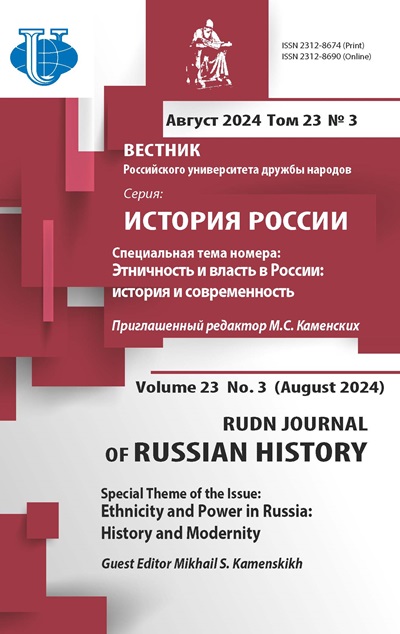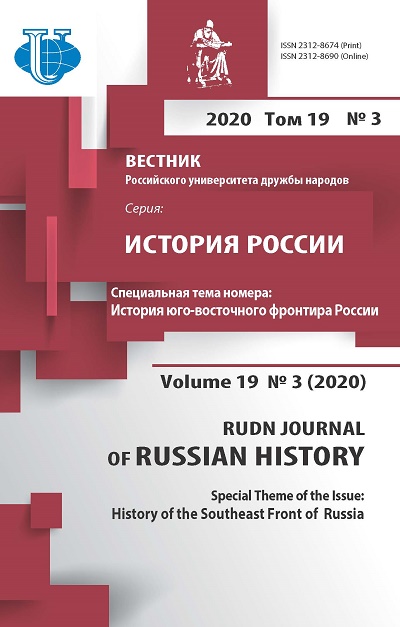The History of Russia’s South-Eastern Frontier: Current Issues, Contemporary Approaches
- Authors: Lyubichankovskiy S.V.1,2
-
Affiliations:
- Orenburg State Pedagogical University
- Samara Federal Research Center Russian Academy of Sciences
- Issue: Vol 19, No 3 (2020): HISTORY OF THE SOUTHEAST FRONT OF RUSSIA
- Pages: 520-524
- Section: IN THIS ISSUE
- URL: https://journals.rudn.ru/russian-history/article/view/24445
- DOI: https://doi.org/10.22363/2312-8674-2020-19-3-520-524
Cite item
Full text / tables, figures
Abstract
-
Full text / tables, figures
Dear readers! We offer this special section to mark the 285th anniversary of the founding of the city of Orenburg (Orsk), on August 26, 1735. It dedicated to the history of Russia’s South-Eastern frontier, which covers the Orenburg region and its adjacent territories. The methodology is the concept of “frontier modernization,” or the development of newly acquired Russian territories to raise their political, legal, and socio-economic level to that of the country’s most advanced developing regions (those regions that have not yet been fully integrated in a state engaged in “modernization”).
The section’s authors address important aspects of intercultural (interethnic and interfaith) interaction in the Orenburg region – an enormous area that, through the early Soviet era, constituted the Bashkir and Kazakh steppe frontier. They focus on such questions as the pacification of the area’s nomadic and semi-nomadic peoples, the Orenburg and Ural Cossacks, imperial and Soviet policy towards minorities (inorodsty), the rise of an intelligentsia among these ethnicities, as well as intercultural interaction during the development of virgin lands.
The section’s articles are arranged chronologically, as well as according to the transition from foreign to domestic policy (which, admittedly, are often difficult to separate from each other in frontier studies). It opens with an innovative article by S.V. Dzhundzhuzov about Prince Petr Taishin that sheds important light on Kalmykia’s incorporation into the Russian Empire during the 18th century. Using the example of an elite Kalmyk, the author reconstructs the state’s approach to integrating and acculturating an eastern nationality. He also convincingly demonstrates that the “Taishin case” led the imperial government to adjust its policy regarding baptized Kalmyks, which went a long way toward reducing social tension in the Kalmyk khanate and helped to populate the Middle Volga and, later, Orenburg. Dzhundzhuzov concludes that the Kalmyk settlements on the Middle Volga established thanks to Petr Taishin made a significant contribution to Orenburg’s economic development and defense.
E.V. Burlutskaia and K.A. Abdrakhmanov also consider the interplay of foreign relations and frontier modernization contribution by examining working conditions among Orenburg merchants who traded with Asia in the 19th century. Taking an Alltagsgeschichte (the history of everyday life) approach, the authors discuss the various challenges the harsh climate imposed on caravan trade, going on to describe the heavy toll in physical deprivation and psychological discomfort.
Any study of integration the southeastern frontier would not be complete without a look at the region’s Cossacks. The article by E.V. Godovova considers the economics of daily life among this population during the post-reform period (i.e., after 1861), as the pace of modernization dramatically quickened. The author described the changes that negatively affected the daily lives of the Orenburg Cossacks, as well as reshaping their agronomic consciousness. She also explains how conditions on the frontier shaped the “Cossack warrior” – “Cossack-farmer,” whose existence was taxed by toil and trouble, especially in summer. Furthermore, over time, inefficient use of the land and frequent poor harvests and repeated redistribution of plots – not to mention the rising cost of military service – all took a toll on their standard living.
The most important aspect of the development of Russia’s South-Eastern frontier was the introduction and adaptation to local conditions of regional self-government, which are addressed in two contributions to this section. Like Godova, I.A. Konovalov also devotes his attention to the Cossacks, focusing on their administration on the frontier with the Kazakh steppe. He convincingly traces the evolution of Cossack self-government over the course of time. In this respect, Konovalov also pays attention to the special role of local stanitsa (village) self-government in the absence of zemstvos, even under excessive bureaucratic control by the state.
D.V. Vasilyev and A.V. Ryabov devoted their attention to the internal political structure of the South-Eastern frontier as well, but in this case by visualizing the imperial space. After analyzing how the indigenous population of Turkestan conducted their meetings with representatives of the Romanovs and the regions’ ruling elite, the authors go on to describe one of the mechanisms for integrating a non-Russian culture into the common socio-cultural space of the empire – the ceremonies to symbolize the unity of the Russian monarchy and Central Asia’s peoples. As the authors demonstrate, this effectively introduced the ideologeme “autocracy – Orthodoxy – nation” in the newly conquered territory, with slight adjustments to the middle link, given the predominantly Islamic population.
The article by S.A. Aleshina and L.V. Petrich focuses on the continuities between imperial and Soviet nationality policy, a topic long neglected or silenced by historians. The authors discus efforts to educate Orenburg’s adult non-Russian population from the turn of the 19th century to the end of the 1930s. They explain that eliminating illiteracy on the South-Eastern frontier was basically a single, cumulative process. By the same token, both imperial and Soviet officials faced similar obstacles, such as a lack of teachers and popular resistance.
E.V. Pakhomova’s study of developing the virgin lands of the Orenburg region and Northern Kazakhstan considers it as a special frontier process. This unique approach permits her to conclude that this undertaking shaped a unique virgin micro-society that reproduced many features of frontier communities. The era’s “virgin meridian” metaphor included the notion of the “new frontier,” which shifted the boundaries of the “wild field” (dikoe pole). As the author convinces us, the frontier specifics of the virgin lands campaign in the Orenburg region ended only in the mid-1960s.
The special thematic section is a valuable contribution to the history of Russia’s South-Eastern frontier both by introducing new sources and innovations in interpreting familiar material. The articles provide a cross-section of the question’s contemporary historiography and they adopt new theoretical and factual approaches. As a result, this section will be of interest both to historians of Russia and its neighbors, thereby attracting wide scholarly attention.
About the authors
Sergey V. Lyubichankovskiy
Orenburg State Pedagogical University; Samara Federal Research Center Russian Academy of Sciences
Author for correspondence.
Email: kaf_rushistory@ospu.su
Doktor Istoricheskikh Nauk [Dr. Habil. in History], Professor, Head of the Russian History Department, Orenburg State Pedagogical University. Leading research fellow, History and Archaeology Department, Samara Federal Research Center Russian Academy of Sciences. Honorary Worker in the Sphere of Education of the Russian Federation.
19, Sovetskaya St., Orenburg, 460844, Russia; 3A, Studencheskiy Line, Samara, 443001, RussiaReferences
















